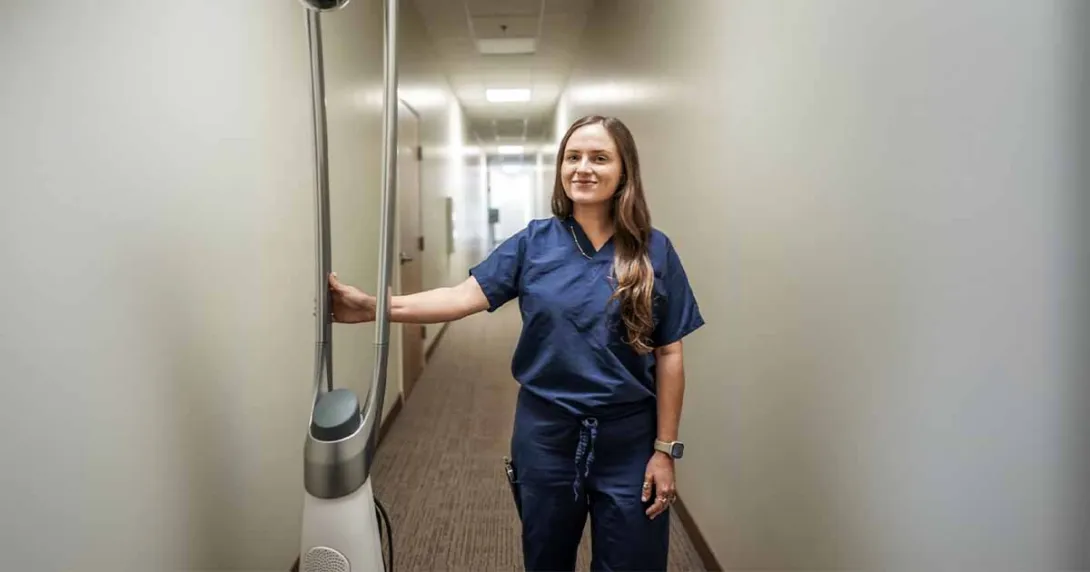
Like many health systems across the country, MUSC in South Carolina faced an escalating nursing shortage that intensified during and after the COVID-19 pandemic. High nurse turnover, increasing patient acuity and a rising number of tasks unrelated to direct patient care placed unsustainable pressure on bedside RNs.
THE CHALLENGE
Many nurses reported burnout driven by non-clinical responsibilities such as discharge education, documentation and monitoring for patient safety. These responsibilities left less time for bedside care. Staffing shortages also led to increased reliance on travel nurses and overtime.
These challenges not only impacted nurse satisfaction and retention but also began to affect key operational and patient experience metrics.
For instance, discharges were frequently delayed due to bottlenecks in patient education and paperwork. Units were unable to consistently monitor high-risk patients for falls or elopement, placing additional liability on already overstretched staff.
Leadership at MUSC recognized that to sustain quality care and improve the patient and nurse experience, the organization needed a new model that reimagined how nursing tasks could be distributed and whether all of them needed to be handled by the bedside nurse.
PROPOSAL
"The proposal entailed a system-wide team-based approach to create virtually integrated care – not just provide virtual nursing," said Cory Robinson, chief administrative officer at MUSC. "To be accomplished, we did collaborative service development between MUSC and our vendor, VirtuAlly, as well as the implementation of both software and hardware in a phased approach, rolling out into our various units.
"The focus was to have bedside nurses focus on things that had to be done at the bedside and leverage virtual nursing for time-consuming tasks such as admissions and discharge planning," he added.
MEETING THE CHALLENGE
MUSC began implementing virtual nursing in October 2023 using a phased approach. The initial deployment focused on two medical-surgical units, with a targeted scope of supporting admissions and discharges.
"We staffed the program with two virtual nurses who provided coverage during the day shift, six days a week, for 12 hours per day," Robinson explained. "These nurses worked remotely but were fully integrated into the care teams, helping with medication reconciliation, admission documentation and patient discharge education via secure, real-time video.
"This initial phase served as a pilot to test workflows, refine the service model and identify areas for optimization," he continued.
During the first three months post-go-live, leadership closely monitored performance and engaged frontline staff to refine workflows and improve communication between bedside and virtual nurses. Based on early success and strong feedback from clinical teams, MUSC moved into a second phase of expansion.
"This phase included increasing coverage to four virtual nurses and expanding responsibilities beyond admissions and discharges to include daily rounding, patient education and clinical documentation support," Robinson recalled. "The team continued to operate from a centralized virtual command center, maintaining strong coordination with on-site teams through Epic EHR integration.
"By the end of 2024, the virtual nursing program was scaled to all four MUSC Health divisions across South Carolina," he continued.
"To support system-wide adoption, we developed an integrated software and hardware strategy. This setup allows virtual nurses to document in real time, engage patients securely, and communicate seamlessly with bedside staff using our enterprise communication platform, Microsoft Teams."
The combination of scalable technology, defined workflows and phased implementation enabled MUSC to effectively redistribute nursing workload. Virtual nurses now play a central role in supporting routine yet time-consuming tasks, freeing up bedside nurses to focus on direct clinical care and improving overall efficiency and staff satisfaction.
RESULTS
"Through our virtual nursing expansion efforts over the last one-and-a-half years, MUSC has served 25,481 unique patient admissions across 33 inpatient units, covering a total of 858 beds," Robinson reported. "Our virtual nursing services span admission, discharge and quality surveillance tasks, with admission being the most utilized, accounting for 20,119 encounters.
"These results were achieved through a phased implementation approach, supported by strong change management practices and ongoing leadership engagement," he continued. "As the program expanded, we consistently monitored outcomes across operational, workforce and patient experience domains to evaluate impact."
MUSC has achieved success in reduced nurse turnover.
"We have seen meaningful reductions in nursing turnover rates on units where virtual nursing is active," Robinson said. "In 2025, one rural med-surg unit experienced a 65% reduction in turnover compared to baseline, while another saw a 40% decrease.
"These improvements are attributed to offloading administrative and non-clinical responsibilities from bedside nurses, enabling them to focus more on direct patient care," he added. "By reducing workload strain and improving role clarity, virtual nursing has contributed to increased job satisfaction and better nurse retention, especially in high-need areas."
Another area of improvement is enhanced employee engagement.
"Employee engagement scores have improved in units supported by virtual nursing," Robinson said. "Nurses report feeling more supported, more efficient and better able to manage their workload. Virtual nurses are recognized as trusted teammates who improve coordination and relieve pressure on bedside staff."
Three months post-implementation in 2025, MUSC gathered direct feedback from bedside nurses:
- 72% agreed or strongly agreed that virtual nursing admission support is helpful.
- 65% agreed or strongly agreed that virtual nursing improves unit throughput.
- 63% agreed or strongly agreed that virtual nursing improves patient safety.
- 67% agreed or strongly agreed that virtual nursing helps them spend more meaningful time with patients.
"These results reflect the value of the virtual model in enhancing the overall care team experience," Robinson said.
Yet another area of improvement is higher HCAHPS patient experience scores.
"Virtual nursing also has contributed to improved patient experience," Robinson reported. "HCAHPS scores related to discharge education increased from 78.7% to 82.5%, while nurse communication scores rose from 71.4% to 74.4%.
"These improvements are driven by the virtual nurse's ability to provide consistent, focused education without the typical interruptions bedside nurses face. This model has helped patients feel more informed and supported during key moments of their hospital stay."
And finally, regarding improvements, there has been a reduction in bedside RN time spent in the EHR.
"One of our core goals was to reduce time spent by bedside nurses in the electronic health record," Robinson said. "While our system-wide target is a 10% reduction, we already have achieved between 9.1% and 13.3% reduction in time spent in the EHR across participating units. This time savings directly translates to more time available for patient care and critical thinking at the bedside."
ADVICE FOR OTHERS
First and foremost, understand this is not just a new technology – it is a care model shift, Robinson advised.
"Success requires more than installing cameras and having fancy software," he said. "It demands cultural adoption, clear workflows, and shared goals between virtual and bedside teams.
"Engage frontline nurses early in the planning phase and co-design processes that make the virtual model feel like a natural extension of the care team," he continued. "Piloting the program on a single unit with strong leadership can help build early wins and pave the way for broader rollout."
Second, make integration a top priority, he said.
"Frictionless integration reduces duplication, improves trust and enables real-time care coordination," he added. "Also, be prepared to iterate. Virtual nursing models must be continuously refined to respond to unit needs, staffing levels and patient acuity.
"Lastly," he concluded, "position this technology not as a workaround for staffing shortages but as a proactive, innovative model of care. When communicated well, virtual nursing can be seen as an opportunity for nurses to practice at the top of their license, improve work-life balance, and stay in the profession longer. It is a long-term investment in both workforce sustainability and patient care quality."
Follow Bill's HIT coverage on LinkedIn: Bill Siwicki
Email him: bsiwicki@himss.org
Healthcare IT News is a HIMSS Media publication.
WATCH NOW: Mount Sinai's new CDIO offers a look at her very full plate


